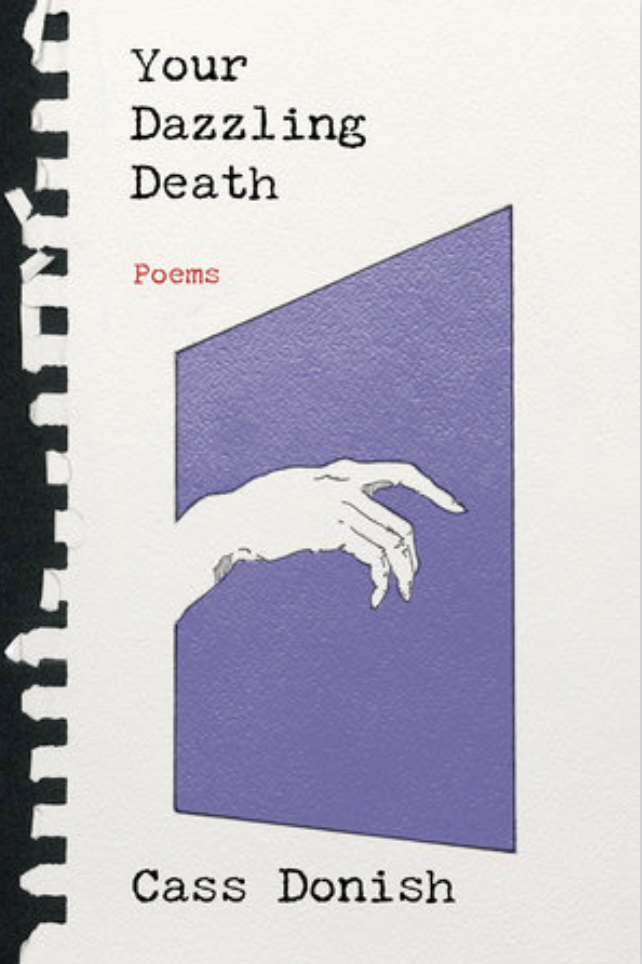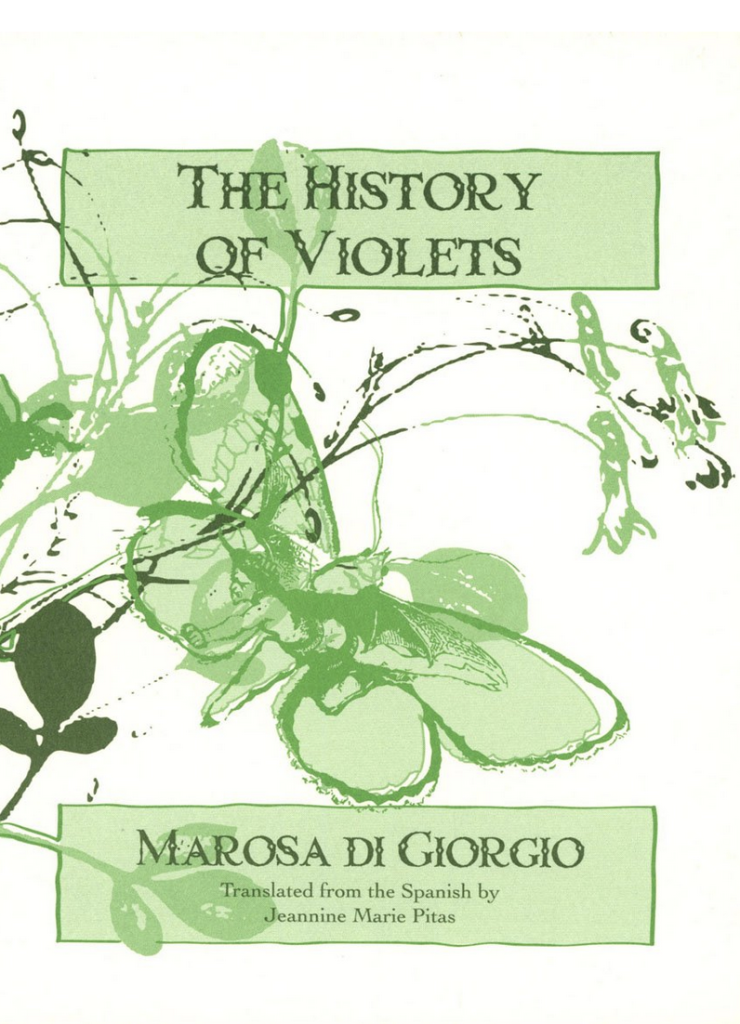Your Dazzling Death by Cass Donish and its connection to Marosa di Giorgio’s Historial de las violetas
About three years ago, I received an email with what seemed an unusual request. Acclaimed US poet Cass Donish wrote to tell me that they had written a palimpsest based on a book that I had translated: The History of Violets by acclaimed Uruguayan poet Marosa di Giorgio (1932-2004). Donish told me they’d been reading and teaching my translations in their class for years, and that when their partner Kelly died tragically, unexpectedly and prematurely by suicide, this particular text helped them to cope with the loss and its aftermath. Writing the palimpsest of di Giorgio’s text—a book-length prose poem that narrates the experience of a child growing up on a family farm populated by gods, angels, monsters, and the ever—sublime presence of nature—helped Donish to navigate their own grief.
Donish was reaching out to ask for permission to publish the palimpsest as part of their book, Your Dazzling Death, a devastating yet beautiful collection of poems based on their relationship with Kelly. Without hesitation I gave my eager consent. Indeed, I was honored to learn that my translation of di Giorgio, whose work I’ve been translating and commenting on for nearly twenty years, had made this kind of personal impact on someone I didn’t know personally. In that moment, the translation work I do—work that can often feel isolating, work rarely understood by the general population and even by literary communities—felt incredibly worthwhile.
Your Dazzling Death is divided into three parts: a series of poems narrating Kelly’s mental health crisis, much of it influenced by the discrimination and social rejection she experienced as a transgender woman; the palimpsest of my translation of di Giorgio’s fourth book, The History of Violets; and then a series of poems in which Donish explores the grief brought on by the loss. The title of the book comes from a line of di Giorgio’s poetry [1]:
I remember nightfall and your room’s open door, the door through which neighbors and angels came in. And the clouds—November evening clouds, drifting in circles over the land. The little trees burdened with jasmine, with doves and droplets of water. That joyous pealing, endless chirping—every evening the same.
And then the next morning, with its tiny dead angels strewn everywhere like paper birds, or the most exquisite of eggshells.
Your dazzling death.
Reading the book in its entirety felt to me like rereading di Giorgio, but in a different time and place, with a focus on a particular person. In a comment on the process of writing the book, Donish states that di Giorgio’s work helped them to find an avenue to approach the loss. “The Catholic undertones and spiritual outgrowths of di Giorgio’s rural Uruguay, inflected with her Italian heritage, absorbed new and different meanings, some of them seeping from the evangelical world of Kelly’s childhood,” Donish states, adding that Kelly “grew up in Mexico, speaking Spanish, a white American missionary kid who would eventually come out as transgender. Di Giorgio, and Pitas, helped me access this telling.”[2]
I am obviously immensely flattered to know that my translation helped Donish to tell their story and Kelly’s. But it also gave me a new perspective on the poet I love and have been translating for so many years. In one poem from The History of Violets, the childhood narrator wakes up in the middle of the night to see a vision of agricultural labor that reads like a painting by Hieronymus Bosch: “Last night I went back; everything happened as I had foreseen. The planting of the hydrangeas. The Virgin—a dove of the night—flying and flying, watching and watching. And my garden stands abandoned,” it begins. After a very vivid description of squashes, birds’ nests, and magnolia trees, we see an image of the child’s grandfather who “is still there, you know? Like a big fungus, a big mushroom, smooth, white, set. He did not recognize me.”[3]
As Donish reads and interprets this poem, they bring the mood, images, and emphasis on nature into their own personal context, from mid-twentieth-century Uruguay to early-twenty-first-century Columbia, Missouri [4]:
On many nights, I went back; everything happened over and over.
I saw figures planting trees at Again Park, but this must have happened before I was born. The owl—custodian of night—soaring in the sky, watching the night. You see, time has abandoned me. Now I foresee the past, and recall what will come. My skin is burning with grief, its gems, its glinting facets. The magnolia is only truly visible at night, those cosmic branches, and blooms of wax held up by stars.
Whenever I cross this threshold of trees, I’m met by strange sounds. In the park, a disoriented moon has risen, a clock with hands whirling, changing faces.
And Kelly is still there, you know? Like a tall flower, smooth, bending in the wind, listening.
She will recognize me.
Reading Donish’s text as a whole, I am astonished and delighted by the depth of the engagement with di Giorgio. It is more than just taking some words from the source text and filling in other words around it.
Like di Giorgio, Donish populates their poetry with images of the natural world, from gemstones to weather to flowers. Like di Giorgio, Donish finds beauty amid deep grief. An obvious difference in this poem is that while di Giorgio expresses deep mourning for a grandfather who “did not recognize me,” Donish looks with faith to the future, asserting that their deceased love is still alive and, at some future moment, will recognize them. But ultimately, both texts combine lament and hope, memorializing the past and envisioning the future, in surprising and unexpected ways. And both texts end with the same striking final line: “I remember eternity.”
I remain honored by the ways that Donish drew upon my translation of di Giorgio to create a translation of their own, bringing the pathos, spirituality, and contemplative grief of this long-unknown Uruguayan writer to their own story of a deeply personal loss in their own United States context. To me, this incident demonstrates the power of poetry in translation to offer beauty and healing across time and space.
—Jeannine Pitas
Notes:
1 Marosa di Giorgio, The History of Violets (New York: Ugly Duckling Presse, 2010), 15.
2 Cass Donish, Your Dazzling Death: Poems (New York: Alfred A. Knopf, 2024), 105.
3 di Giorgio, 23.
4 Donish, 46; the grayed text is Donish’s own formatting.
* * *


